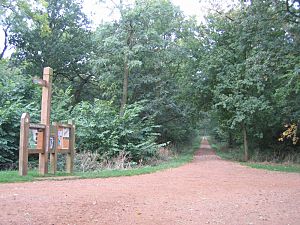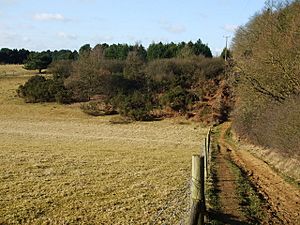Maulden Wood facts for kids
| Site of Special Scientific Interest | |
 |
|
| Area of Search | Bedfordshire |
|---|---|
| Interest | Biological |
| Area | 148.8 hectares |
| Notification | 1986 |
| Location map | Magic Map |
Maulden Wood is a beautiful woodland located in Bedfordshire, England. It's close to the village of Maulden and sits on a special natural ridge called the greensand ridge. This ridge stretches all the way from Leighton Buzzard to Gamlingay. Part of this area, known as Maulden Wood and Pennyfather's Hill, is a very important place for nature. It covers 148.8 hectares and is officially recognized as a biological Site of Special Scientific Interest (SSSI). This means it's protected because of its unique plants and animals.
Contents
Exploring Maulden Wood
Maulden Wood is a mix of different types of trees and open spaces. It has many broadleaf trees that lose their leaves in autumn, along with some evergreen trees like pines. There are also areas of grassy land. You can find paths into the wood from Maulden Church, by walking through Church Field. Another way to get in is from a special parking area (layby) on the A6 road. In the middle of the wood, you'll discover open grasslands. The Greensand Trust and the Forestry Commission work together to take care of this amazing place.
Why Maulden Wood is Special
Much of Maulden Wood is a Site of Special Scientific Interest (SSSI). This is because it has important acidic grasslands and heathland, which are rare habitats.
Amazing Animals of the Wood
The wood is home to many different animals. You might spot badgers in their underground homes, foxes, and even barn owls flying silently at night. The varied soil, which includes clay and sandy gravel, makes it a perfect home for many small creatures like insects and other invertebrates.
One interesting creature found here is a type of slug called limax cinereoniger. Finding this slug often means the woodland is very old and hasn't been disturbed much.
Wonderful Plants of the Wood
Maulden Wood is also home to some special plants. The rare Wild Service Tree (Sorbus torminalis) grows in the drier parts deep inside the wood.
The northern part of Maulden Wood is especially important because it's one of the largest remaining pieces of ancient woodland in Bedfordshire. Ancient woodlands have been around for a very long time, often for hundreds of years!
Because of the many pine and other evergreen trees, Maulden Wood stays green almost all year round. Around the edges of the wood, you'll find hedgerows with plants like bindweed, sticky willy, honeysuckle, and trumpet flowers. In early spring, the ground is covered with beautiful snowdrops and cowslips. Later in spring, the middle of the wood and the pathsides turn blue with carpets of bluebells.
The southern part of the wood is sometimes called Pennyfather's Wood. This area sits on greensand, which is a different type of soil compared to the rest of Maulden Wood, which has a layer of glacial clay.
Tiny Creatures: Sawflies and More
The wood is also home to some rare types of sawflies, which are insects related to bees and wasps. These include Pamphilius sylvarum and Caliroa cinxia, which like to feed on the leaves of the oak trees found here. Another sawfly, Pamphilius gyllenhali, has been seen in the wood and feeds on willow trees.
Besides sawflies, many other important invertebrate groups live in Maulden Wood. These include different kinds of beetles, colorful dragonflies, and beautiful butterflies.
History of Maulden Wood
The northern part of Maulden Wood holds secrets from the past. Along Limbersey Lane and at the site of Limbersey Farm, archaeologists have found signs of Roman and Iron Age settlements. This means people lived and worked here thousands of years ago!
There are also signs of medieval times (the Middle Ages) within the wood, especially in the northern and western areas. These sites give us clues about how people lived in the past.
Visiting Maulden Wood
Maulden Wood is a great place to visit and is open to everyone all year round. You can get into the wood from the Deadman's Hill layby, which is a parking area right next to the wood on the A6 road. You can also access it from Maulden Church Meadow. It's a wonderful spot to explore nature and enjoy the outdoors!


